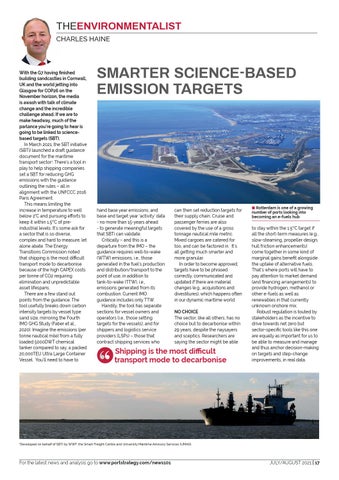THEENVIRONMENTALIST CHARLES HAINE
With the G7 having finished building sandcastles in Cornwall, UK and the world jetting into Glasgow for COP26 on the November horizon, the media is awash with talk of climate change and the incredible challenge ahead. If we are to make headway, much of the parlance you’re going to hear is going to be linked to sciencebased targets (SBT). In March 2021, the SBT initiative (SBTi) launched a draft guidance document for the maritime transport sector1. There’s a tool in play to help shipping companies set a SBT for reducing GHG emissions with the guidance outlining the rules – all in alignment with the UNFCCC 2016 Paris Agreement. This means limiting the increase in temperature to well below 2°C and pursuing efforts to keep it within 1.5⁰C of preindustrial levels. It’s some ask for a sector that is so diverse, complex and hard to measure, let alone abate. The Energy Transitions Commission noted that shipping is the most difficult transport mode to decarbonise because of the high CAPEX costs per tonne of CO2 requiring elimination and unpredictable asset lifespans. There are a few stand out points from the guidance. The tool usefully breaks down carbon intensity targets by vessel type sand size, mirroring the Fourth IMO GHG Study (Faber et al., 2020). Imagine the emissions (per tonne nautical mile) from a fully loaded 5000DWT chemical tanker compared to say, a packed 20,000TEU Ultra Large Container Vessel. You’ll need to have to
SMARTER SCIENCE-BASED EMISSION TARGETS
hand base year emissions, and base and target year ‘activity’ data - no more than 15-years ahead - to generate meaningful targets that SBTi can validate. Critically – and this is a departure from the IMO – the guidance requires well-to-wake (WTW) emissions, i.e., those generated in the fuel’s production and distribution/transport to the point of use, in addition to tank-to-wake (TTW), i.e., emissions generated from its combustion. Current IMO guidance includes only TTW. Handily, the tool has separate sections for vessel owners and operators (i.e., those setting targets for the vessels), and for shippers and logistics service providers (LSPs) – those that contract shipping services who
‘‘
can then set reduction targets for their supply chain. Cruise and passenger ferries are also covered by the use of a gross tonnage nautical mile metric. Mixed cargoes are catered for too, and can be factored in. It’s all getting much smarter and more granular. In order to become approved, targets have to be phrased correctly, communicated and updated if there are material changes (e.g., acquisitions and divestitures), which happens often in our dynamic maritime world. NO CHOICE The sector, like all others, has no choice but to decarbonise within 29 years, despite the naysayers and sceptics. Researchers are saying the sector might be able
Shipping is the most difficult transport mode to decarbonise
8 Rotterdam is one of a growing number of ports looking into becoming an e-fuels hub
to stay within the 1.5⁰C target if all the short-term measures (e.g., slow-steaming, propeller design, hull friction enhancements) come together in some kind of marginal gains benefit alongside the uptake of alternative fuels. That’s where ports will have to pay attention to market demand (and financing arrangements) to provide hydrogen, methanol or other e-fuels as well as renewables in that currently unknown onshore mix. Robust regulation is touted by stakeholders as the incentive to drive towards net zero but sector-specific tools like this one are equally as important for us to be able to measure and manage and thus anchor decision-making on targets and step-change improvements, in real data.
Developed on behalf of SBTi by WWF, the Smart Freight Centre and University Maritime Advisory Services (UMAS).
1
For the latest news and analysis go to www.portstrategy.com/news101
JULY/AUGUST 2021 | 17









